QuestionI would like to buy a "beginner" aquarium for my ine year
old daughter. Are the pet chains good places to buy? Is
there a recommended complete set? Are there better fish
to begin with.
Thanks.
AnswerHi John;
I am so glad to hear from you before you get started! I usually don't hear from new hobbyists (or parents of) until there has been a lot of mistakes and many sick or dead fish. You will avoid most of those problems by utilizing the information you will now be armed with. You can buy your fish in a chain store, but if there is a local small store wih knowledgeable personnel and healthy fish it may be better to buy there. Visit a prospective store 3 or 4 different times. If the store in question has dead fish in the tanks every time, do not buy any fish there. Every once in awhile a fish store has a bad batch of fish that just came in or just a bad day. That's why it is important to check them out over a period of several days. It is an investment of time, but you won't regret knowing what you need to so you can get healthy fish.
When beginning in fish keeping, the bigger the tank the better. Avoid anything smaller than 10 gallons, and 20 or larger is better. At the end of this letter I will include my article about new tanks for you to read. Break-in takes about 6 weeks. For that first 6 weeks you only want to have one inch of fish for 10 gallons. Too many starter fish equals more toxins which leads to fish illness or even death. Take it slow and your tank should do very well.
Here are some links to web sites you can go to for choosing a tank, choosing fish, understanding how to start a tank and what you need for it;
http://freshaquarium.about.com/od/aquariumstartup/
http://fins.actwin.com/mirror/begin.html
http://www.fishpalace.org/Tank.html
http://badmanstropicalfish.com/community.html
Community tanks choices of fish for new hobbyists;
http://www.fishpalace.org/Community.html
http://badmanstropicalfish.com/charts/good_bad.html
http://www.aquariumpros.com/articles/fishcyclefw.shtml
Other helpful beginner info;
http://freshaquarium.about.com/cs/beginnerinfo/a/fishcalc.htm
http://freshaquarium.about.com/cs/qa/l/blqa2006.htm
http://freshaquarium.about.com/od/aquariumstartup/a/newtankmistakes.htm
http://freshaquarium.about.com/cs/fishspecies/l/blfishlibrary.htm
Something you should know about too is that many fish store employees don't know this information themselves. Or worse, they simply choose to let people overstock their tanks full of incompatable fish that die in the first week in their new home. The customers come back and restock with new fish and spend more money trying to treat a disease that doesn't exist with medicine they don't need. The fish simply died from "New Tank Syndrome" or shock. After a few tries the new fish owner is successful because the tank did break-in eventually while all the fish were suffering and dying. It's sad really. Especially considering that there is a better way to go about it.
Here is my article on new tanks to help you through the first few weeks;
**********
New Tank Syndrome or Break-in Period
So you have a new tank and you filled it up, put the filter together, mounted the heater into place and turned on the lights. You have all the plants and decorations where you want them....
You are ready for fish.
But, your filter is not ready for a full tank of fish yet.
The filter is running and moving the water and cleaning out crud, right? Of course!
But a very important part of your filter is the part you can't see. An aquarium filter removes the larger visible stuff, but it also must remove the dissolved fish waste that turns into ammonia in the water. To do this, special bacteria must grow in the filter system and on the particles of gravel in the bottom of your tank. This process occurs even on a limited scale in little fish bowls that have no filter in them.
This is "New-Tank Syndrome" or the "Break-in Period". The entire process takes 6 to 8 weeks to complete because these "nitrifying" bacteria grow quite slowly.
Start off with only one or two hardy fish (no more than 2 total inches of fish) for every ten gallons of water and don't add more until the 6 to 8 weeks has gone by. Hard to be patient, but it is worth it to keep your fish alive and healthy. As a matter of fact, the bacteria cannot develop without fish in the tank. You can let that tank sit forever without fish in it, but as soon as the first fish goes in the process begins. Avoid changing the filter pads during break-in. This removes the bacterial colonies that are essential to a balanced aquarium. You can rinse the filter pad out in a container of aquarium water. This will preserve most of the bacteria colonies while still allowing your filter to flow freely. Even using bacteria additives and water conditioners when you first set up the tank will not make a tank begin the cycle by itself. If there are no fish to provide food (fish waste) for the bacteria, the beneficial bacteria cultures will die and you will have to start the colonies all over again once fish are added to the tank. Once the tank has completed the initial cycle, you can change the filter pads every 4 weeks or so. But for now, just rinse them.
Feed your new fish VERY lightly. Any excess food will cause additional waste your system cannot afford to have right now. If you see food floating around or lying on the plants and gravel after five minutes, too much food is going into the tank. Cut back a little each time you feed until it is ALL gone 5 minutes after you feed them. Feed them once a day.
During this "break-in period" your tank will become cloudy and milky looking. You may have to tolerate this for the entire break-in period but it is only temporary. Changing 25% of the water three times a week until the break-in period is over helps a great deal. Changing water reduces the ammonia and nitrites that rise while the bacteria continues to multiply. If ammonia and/or nitrites become too high, your fish will become stressed and possibly die. Use a good water conditioner when you replace the water and make sure it is the right temperature to avoid shocking your fish.
When the break-in is over after 6 to 8 weeks and there are no nitrites or ammonia present in the water you can slowly add more fish. Add one or two every week until you reach the desired population. This allows the bacteria to adjust to the new population every time before adding more. Monitor the nitrites and ammonia to be sure they don't come up. If they do, make a 25% water change and check them again. Don't add the next fish until the levels are down again.
The safe maximum population for any size tank is one inch of adult fish for every gallon of water in the tank. Do some research to be sure of the fish you are interested in. Even though they are small when you buy them, you have to base your population calculations on full-sized adult fish. Many hobbyists have up to two inches per gallon but this can be risky. If a water quality issue arises or a disease occurs it will spread fast and furious in an over-populated tank. In any case, 25% water changes every week to two weeks are absolutely essential for the health of your fish.
Following these guidelines will help you get your new tank on the right track.
**********
At Your Service;
Chris Robbins
Come on over and join us on the freshwater fish forum at About.com to get even more information too;
http://freshaquarium.about.com/od/questionsanswers/a/naavigateforum.htm

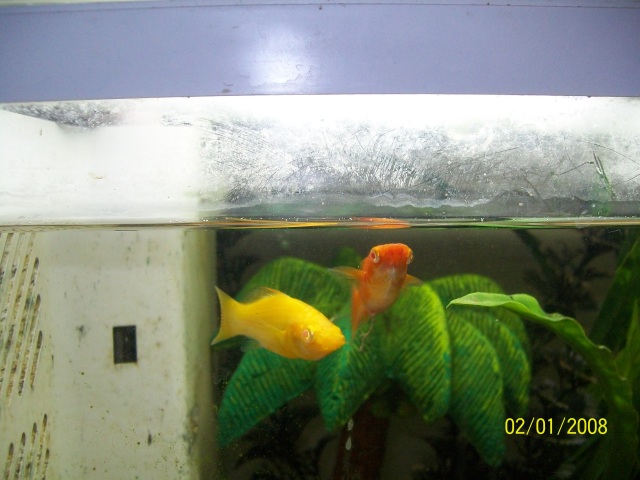 simple question
Question
Mollies
I have 2 orange Mollies. I think one i
simple question
Question
Mollies
I have 2 orange Mollies. I think one i
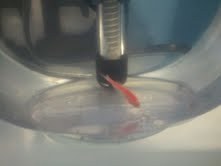 fish disease?
Question
Fish tail
Hello,
I have a 20 gallon tank that
fish disease?
Question
Fish tail
Hello,
I have a 20 gallon tank that
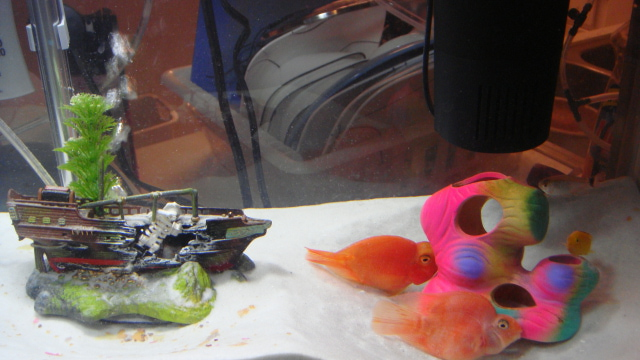 Problem on my parrot fish
QuestionQUESTION: Last Saturday, i noticed my 2 parrot
Problem on my parrot fish
QuestionQUESTION: Last Saturday, i noticed my 2 parrot
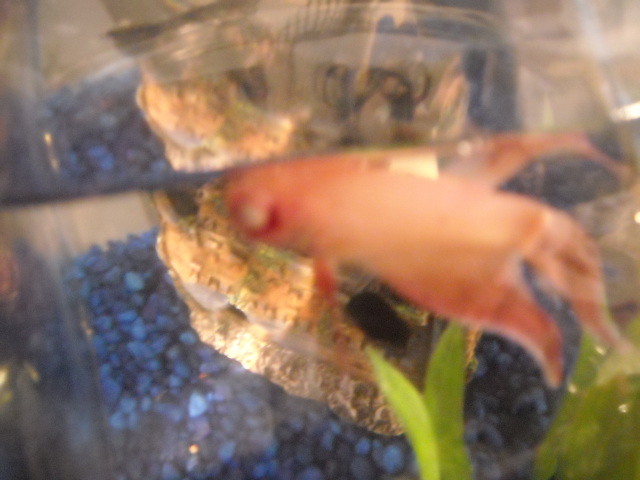 Popeye Betta
Question
popeye
My betta fish started showing si
Popeye Betta
Question
popeye
My betta fish started showing si
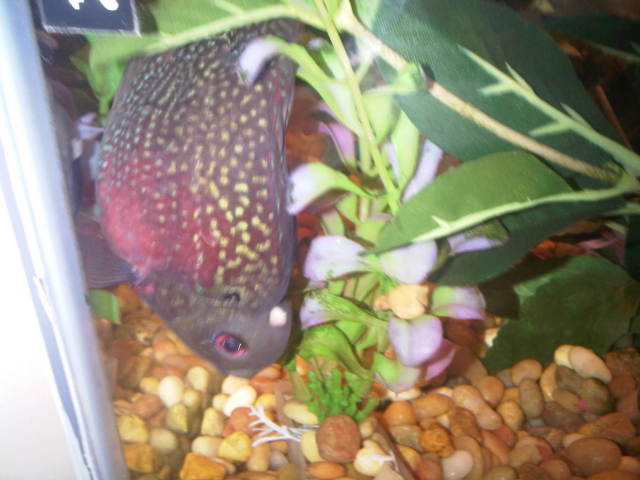 Parrot Fish - White Spot
Question
Fish Spot
Hi Ms. Fields,
I have 3 parro
Parrot Fish - White Spot
Question
Fish Spot
Hi Ms. Fields,
I have 3 parro